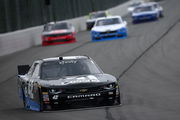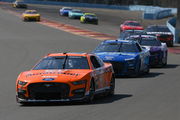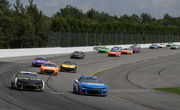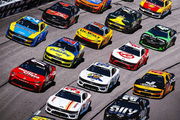
via Imago
July 2, 2023, Chicago, Illinois, USA: NASCAR, Motorsport, USA Cup Driver, AJ ALLMENDINGER 16 races for position for the Inaugural Grant Park 220 on the Chicago Street Course. Chicago USA – ZUMAries 20230702_mda_a161_235 Copyright: xLoganxTxArcex Image Credits: Imago

via Imago
July 2, 2023, Chicago, Illinois, USA: NASCAR, Motorsport, USA Cup Driver, AJ ALLMENDINGER 16 races for position for the Inaugural Grant Park 220 on the Chicago Street Course. Chicago USA – ZUMAries 20230702_mda_a161_235 Copyright: xLoganxTxArcex Image Credits: Imago
Optimizing the car for safety has been one of NASCAR’s top concerns. Since the introduction of the Next-Gen cars, NASCAR has been looking for constant solutions to the shortcomings of their cars. In recent news, the research team has come up with another aid for drivers to improve the stability of the cars trailing the leader on short-track races.
Providing more downforce to the car, the splitters will help with the dirty air problems that the vehicles have been facing in traffic. The change comes with the visualization of more cars passing on short tracks in mind.
ADVERTISEMENT
Article continues below this ad
What is the change NASCAR is hoping to see?
Adding the splitter will create extra lift in clean air and more downforce during congested lanes. The race leader usually has the optimal downforce with their car since they are at the front where the air is clean. The victims of this case are the drivers that trail the leading car. The splitter will essentially reverse this effect and allow the chaser to compensate for the distance to the car ahead with more downforce applied.
Joe Gibbs Racing driver Christopher Bell is one of the advocates of this change. In a recent press conference in Atlanta, he explained, “It creates lift in clean air. The goal is, when you get into traffic and lose airflow to your splitter, it gives you more downforce than you would by yourself.”
The working principle of a splitter is to split the air so that the racing car dives into forcing the high-pressure air to come above the vehicle while lower-pressure air goes below it. The high-pressure air, as a result, exerts a downward force on the car, giving it more traction and stability on the track. The only shortcoming of this implementation is that it affects the leader by generating more drag force and lift.
Christopher Bell explains the proposed short track package that will be tested at New Hampshire.
It's a splitter that creates lift in clean air but provides downforce in traffic. pic.twitter.com/5USnJMfjB4
— Matt Weaver (@MattWeaverRA) July 8, 2023
Trending
“It’s like cutting weed at the top instead of the root”: Avid NASCAR followers bring their expert perspectives into the discussion
The fandom has thrown wild guesses into how much impact this has on the racing. While some have raised concern over the stress on the tires leading to them blowing up, others have questioned whether the change actually changes anything in the car.
This fan brought Denny Hamlin’s argument to the discussion. They said, “I hope it works as well, but am skeptical. As Hamlin has stated in the past, it is not an aero issue at short tracks as much as it is the fact that these guys are going the same speeds and the cars handle too good mechanically. There’s no more wheel hop, RPM’s are too low, tires are too wide and the brakes are gigantic, making the braking zones much shorter. Until NASCAR starts looking at reducing mechanical grip, the issue won’t be solved through any amount of CFD. I’m sure it will help some with following and not losing the nose, but it doesn’t address the main concern. It’s like cutting a weed at the top instead of at the root. Sure it shortens the weed, but it’s not killing the weed.”
ADVERTISEMENT
Article continues below this ad
“Can’t make the tires much softer at places like Bristol which already have a problem with blowouts,” said a fan. The comment gets corrected by another Redditor who said, “I believe the tires blowing out is separate from the wear issue, at least in most cases, they aren’t wearing a hole in the tire. The teams put these tires at pressures and levels that put them at higher risk.”
I had this conversation with @BoziTatarevic last year at Charlotte and we both generally thought it was worth the R&D time. I'll defer to him on the ultimate pros and cons from an engineering standpoint.
— Matt Weaver (@MattWeaverRA) July 8, 2023
ADVERTISEMENT
Article continues below this ad
Another fan on Twitter wonders if changing the tire width would be of any help. Considering that tires of narrower width could help with the issue, it seems quite a reasonable argument. Another set of fans has brought up the idea to introduce harder brake pads. That will decrease the strain of braking force on the car by spreading the clamping force. Not just that but it would increase the amount of clamping force the brakes can bear. What do you think?
Watch This Story: This surprising contender could potentially replace Aric Almirola in Tony Stewart’s team
ADVERTISEMENT
ADVERTISEMENT
ADVERTISEMENT
ADVERTISEMENT






